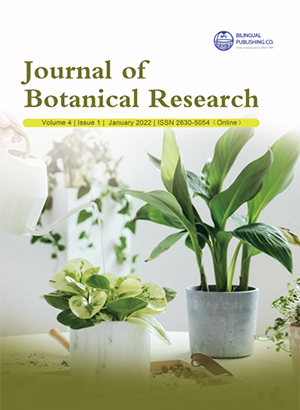-
28845
-
17504
-
3260
-
1194
-
1168
Wild Edible Plants Used by the Tribes of Panvel and Uran Tahsils in Alibaugh District, India: Ethnobotanical Application and Tribal Recipes
DOI:
https://doi.org/10.30564/jbr.v4i1.4280Abstract
The “Indus-Vedic” cultural heritage of India is well-known. Wild edible plants, sometimes known as weeds, are widely consumed in India’s varied areas. Wild edible plants and weeds are essential for tribes’ survival, both as a source of food and as a source of money, such as timber. This study aims to identify wild vegetables collected for ethnomedical purposes and their recipes by the local people, as well as determine the local uses and names of these plants, with the goal of closing the gap in traditional knowledge regarding the utility of wild plant species and tapping the hidden potential resources for proper utilization, exploitation, and nutritive evaluation. A field research study was conducted two years 2020-2021. 34 wild vegetable plant specimens were collected during this time. The names of the plants found in the area, as well as the parts that were used and how they were prepared, were examined and recorded. This type of extensive survey technique could assist aspiring scientists in learning about the health advantages of wild food plants and weeds, which can subsequently be combined to generate successful crop plants. Such a system will benefit in the mitigation of food shortages, the regeneration of infertile lands, and the enhancement of rural economies.
Keywords:
Wild vegetable, Ethnobotany, Traditional knowledge, Tribals, RecipeReferences
[1] Save, K.J., 1945. The Warlis Padma Publication Ltd.Bombay.
[2] Gupta, B.M., Bhandare, R., 1972. Nutritional status of tribal and nontribal rural per school children around Udaipur. Indian Journal Pediatrics. 39, 317- 326.
[3] Rao Nageshwara, C., Rao Narsinga, B.S., 1970. Absorption of dietary carotenes in human subject. American Journal Clinical Nutrition. 23, 105.
[4] Pant, K., 1996. Nutritive values of some non-conventional vegetables used in tribal area of Thane district M.Sc. Thesis Bombay University.
[5] Bhogaonkar Prabha, Y., Vishal, R., Marathe, Kshirsagar Prachi, P., 2010. Documentation of Wild edible plants of Melghat forest, Dist. Amaravati, Maharashtra state, India. Ethnobotanical Leaflet. 14, 751-58.
[6] Marathe, C.L., 2012. Sustainable utilization of plant resources from tribal areas of Thane district Maharashtra. Ph.D. thesis submitted to North Maharashtra University, Jalgaon.
[7] Tapan, S., Basundhara, P., Chaudhari, K., 2017. Evaluation of nutritional Potential of five unexplored wild edible plants consumed by the tribal people of Arunachal Pradesh state in India. Journal of food and Nutritional Research.5,1-5.
[8] Saikia. P., Deka, D.C., 2013. Mineral content of some wild green leafy vegetables of North –East India. Journal of chemical and pharmaceutical research. 5(3), 117-121.
[9] Ramachandran, V.S., 2007. Wild edible plants of the Anamalai Coimbatore district Western Ghats. Tamilnadu. Ind.J. Trad. Knowledge. 6(1), 173-176.
[10] Sundriyal, M., Sundriyal, R.C., Sharma, E., 2004. Dietary uses of wild plant resources in the Sikkim Himalayas. India. Econ.Bot. 58(4), 626-638.
[11] Majumdar, K., Datta, B.K., Ray, D., 2009. Traditional wild edible fruits for forest dwellers of Tripura. India. Pleione. 3(2), 172-180.
[12] Khyade, M.S., Kolhe, S.R., Deshmukh, B.S., 2009. Wild edible plants used by the tribes of Akola Tahsil of Ahmednagar District, (M.S.), India. Ethnobot. Leaflet. 13, 1328-36.
[13] Khan Tabassum, M.A., Kakde Umesh, B., 2014. Biodiversity in wild vegetables of Konkan region International Journal of Researches in Biosciences, Agriculture & Technology. 2(1), 1-15.
[14] Satvi, V., Marathe, C.L., 2018. Wild Edible plants used as vegetable by rural communities of Palghar District, Maharashtra, India, Review of Research. 8(3),1-5.
[15] Almeda, M.R., 1996. Flora of Maharashtra. Volume-1-2.
[16] Cooke, T., 1967. The Flora of the Presidency of Bombay. Vol. I, II, III. Botanical Survey of India. Calcutta.
[17] Jain, S.K., Rao, R.R., 1977. A handbook of field and Herbarium methods. Today and Tomorrow’s Printer Publisher, New Delhi.
[18] Shah, G.L., 1978. Flora of Gujarat state Saradar Patel University, V.V Nagar Gujarat.
[19] Naik, V.N., 1998. Marathwadyatil Samanya Vanaushhadhi (Marathi). Amrut Prakashan, Aurangabad.
[20] Nutrition news, 1996. National Institute of Nutrition, Hyderabad. 17, 2.
[21] Sundriyal, M., Sundriyal, R.C., Sharma, E., 2004. Dietary Use of Wild Plant Resources in the Sikkim Himalaya, India. Economic Botany. 58(4), 626-638.
[22] Bhogaonkar, P.Y., Marathe, V.R., Kshirsagar, P.P., 2010. Documentation of Wild Edible Plants of Melghat Forest, Dist. Amravati, Maharashtra State, India. Ethnobotanical Leaflets. 14, 751-758.
[23] Setiya, A.V., Narkhede, S.D., Dongarwar, N.M., 2016. Exploration and documentation of some wild edible plants used by the aboriginals from Gadchiroli District (M.S.) India. International Advanced Research Journal in Science, Engineering and Technology. 3(7), 24-35.
[24] Reddy, B.M., 2012. Wild edible plants of Chandrapur district, Maharashtra, India. Indian Journal of Natural Product and Resources. 3(1), 110-117.
[25] Rai, M., Singh, J., Pandey, A.K., 2004. Vegetables: A source of nutritional security. Indian Hort. 48(4), 14- 17.
[26] Kulkarni, D.K., 2006. Role of ethno-botany in Modern Agriculture. National Conference on Bridging Gap between Ancient and Modern Technologies to Increase Agricultural Productivity.
[27] Kulkarni, D.K., Agte, V.V., Kumbhojkar, M.S., 2003. Leafy vegetables consumed by Mahadeo Koli tribe in Western Maharashtra with their nutritional potential. Ethnobotany. 15, 34-38.
Downloads
How to Cite
Issue
Article Type
License
Copyright © 2022 Author(s)

This is an open access article under the Creative Commons Attribution-NonCommercial 4.0 International (CC BY-NC 4.0) License.




 V.M. Jamdhade
V.M. Jamdhade





